UPSC Daily Current Affairs- 2nd August 2023 | Current Affairs & Hindu Analysis: Daily, Weekly & Monthly PDF Download
GS-I
Climate finance adds another layer of inequity to climate change
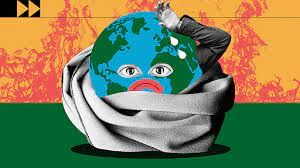
Why in News?
In recent years, climate justice activists have been advocating for economically developed countries to increase their investments in climate adaptation and mitigation, including supporting other nations in dealing with the impacts of climate change.
Central idea
- Countries in Sub-Saharan Africa, Latin America, and South Asia, despite contributing the least to global warming, are disproportionately affected by climate disasters and burdened with debt distress. In contrast, North American and European countries, which have historically been the major contributors to greenhouse gas emissions, also hold significant roles as creditors in the ongoing debt crisis.
Carbon Emissions per Capita in Various Regions
- Global Average Emissions: The global average emissions per capita have consistently remained above 4.7 tonnes per capita since 2010. This value is twice the baseline target needed to limit global warming to 1.5 °C.
- Africa and India: Countries in Africa and India have consistently emitted carbon dioxide per capita below the global average. Despite being major contributors to the global population, their carbon emissions per capita have been comparatively lower.
- China: China crossed the global average carbon emissions per capita in 2004 and has steadily increased since then. By 2021, China’s per capita emissions would reach 8 tonnes, placing it on par with Europe and Oceania.
- UAE and the U.S.: Despite observing an overall decline in emissions, the UAE and the U.S. still had the highest carbon emissions per capita as of 2021. The UAE’s per capita emissions were recorded at 21.8 tonnes, while the U.S. stood at 14.9 tonnes
Investment in Climate-related Activities by World Bank Regions
- Sub-Saharan Africa: This region had the highest investment fraction in climate finance, allocating 1.3% of its GDP towards climate-related activities in both 2019 and 2020. This indicates a significant commitment to addressing climate challenges.
- East Asia and the Pacific: Following closely behind, this region allocated 1% of its GDP to climate-related initiatives, showcasing a considerable effort in climate finance.
- South Asia: The region dedicated 0.9% of its GDP to climate-related activities in both years, reflecting a notable commitment to addressing climate change impacts.
- U.S. and Canada: In contrast, the United States and Canada contributed the least among the World Bank regions, allocating only 0.3% of their GDP to climate-related projects in 2019 and 2020.
International Multilateral Climate Funds Disbursement
- Disbursement Disparity: Since 2003, a total of $3.3 billion has been approved to be disbursed to South Asia through these multilateral climate funds. However, only $1.3 billion was actually disbursed. This indicates a significant disparity between approved funds and actual disbursements.
- Global South Funding: A large fraction of the funds for climate mitigation and adaptation in the Global South come from international multilateral climate funds. These funds are primarily sourced from economically developed countries.
- Suboptimal Disbursement: On average, most regions received only 40% of the approved funding intended for their climate projects. This points to challenges with efficient fund allocation and disbursement.
Climate Vulnerability Index
- The Climate Vulnerability Index is calculated annually by the Notre Dame Global Adaptation Initiative and combines a country’s exposure, sensitivity, and capacity to adapt to climate change. The Risk of Debt Distress is based on the International Monetary Fund’s Debt Sustainability Framework reports.
Climate Vulnerability Index by country and the Risk of Debt Distress by region
- Climate Vulnerability Index: Most notably, countries in Sub-Saharan Africa emerge as the most vulnerable to climate change, facing higher risks due to their exposure, sensitivity, and limited capacity to adapt to climate impacts.
- Risk of Debt Distress: Sub-Saharan Africa stands out as the region with several countries at high risk of or facing debt distress, further exacerbating their vulnerability to climate change.
- Correlation: Most of the countries experiencing high climate vulnerability are also at risk of debt distress, highlighting the interconnectedness of climate change impacts and financial challenges.
- High-Income Country Exclusion: Several high-income countries were excluded from the analysis due to limited data. Therefore, the focus of the chart is primarily on countries in the Global South.
Expressed concern from the above observations
- Disproportionate Vulnerability: The observations highlight the inequity in climate impacts, where regions that have historically contributed less to greenhouse gas emissions are disproportionately bearing the brunt of climate disasters.
- Financial Vulnerability: Climate-related impacts can exacerbate existing economic vulnerabilities, leading to a higher risk of debt distress, which, in turn, hampers their capacity to address climate change and sustainable development needs effectively.
- Climate Finance Disparity: The disparity between approved funds and actual disbursements through international multilateral climate funds is worrying. This raises questions about the efficiency of fund allocation and disbursement.
- Limited High-Income Country Data: The exclusion of several high-income countries from the analysis due to limited data poses concerns about the comprehensive understanding of global climate vulnerabilities.
- Interconnected Challenges: The interconnection between climate vulnerability, debt distress, and development challenges implies that addressing one issue without considering the others may not yield sustainable solutions.
Way forward
- Increased Climate Finance:
- Economically developed countries must urgently increase their financial contributions to support climate adaptation and mitigation efforts in vulnerable regions.
- Meeting the target of $100 billion annually for climate finance is crucial to aid vulnerable countries in building resilience and reducing greenhouse gas emissions.
- Debt Relief for Vulnerable Countries:
- High-risk and debt-distressed countries should be offered debt relief measures specifically tied to climate action.
- Debt-for-climate swaps and innovative financial instruments can help these nations allocate more resources to climate resilience and sustainable development.
- Technology Transfer and Capacity Building:
- Accelerate the transfer of clean and sustainable technologies to vulnerable countries, providing them with the tools and knowledge to adapt to climate change and reduce emissions effectively.
- Capacity building efforts should be prioritized to enhance local communities’ abilities to implement climate-friendly solutions.
- Adaptation and Resilience Investment:
- Urgently invest in climate adaptation projects that enhance the resilience of vulnerable communities and ecosystems.
- Prioritize infrastructure improvements, nature-based solutions, and disaster risk reduction measures to protect lives and livelihoods from climate-related impacts.
- Ambitious Emission Reduction Targets:
- Pursue ambitious emission reduction targets at the national and global levels.
- All countries, especially economically developed ones, should take the lead in transitioning to clean energy sources and decarbonizing their economies to limit global warming
Conclusion
- The current disparity in climate financing between economically developed countries and those in Sub-Saharan Africa, Latin America, and South Asia raises concerns about climate justice and the urgent need to bridge the gap. Only through collective and equitable action can we build a sustainable and resilient future for all.
Source: The Hindu
Lokmanya Tilak National Award
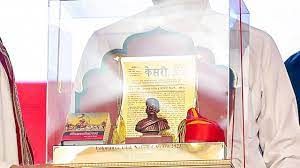
Why in News?
Recently, Prime Minister Modi was conferred Lokmanya Tilak National Award.
Background:-
- Prime Minister Narendra Modi was given the Lokmanya Tilak National Award for his outstanding contributions towards the progress of the country.
- He was given the award at a function in Pune this afternoon.
About Lokmanya Tilak National Award:-
- Instituted: 1983
- Instituted by: Tilak Smarak Mandir Trust.
- This award is given every year on 1st August.
- Significance: It is to mark the death anniversary of Lokmanya Tilak.
- It is awarded to persons who have made remarkable and extraordinary contributions, working for the progress and development of the nation.
About Bal Gangadhar Tilak:-
- Birth: July 23, 1856.
- Birthplace: Ratnagiri (now in Maharashtra state), India.
- Death: August 1, 1920, in Mumbai.
- He was a scholar, mathematician, philosopher, and ardent nationalist who helped lay the foundation for India’s independence by building his own defiance of British rule into a national movement.
- He was also known as Lokmanya Tilak.
- His famous declaration “Swaraj is my birthright, and I shall have it” served as an inspiration for future revolutionaries during India’s struggle for freedom.
- The British Government termed him the “Father of Indian Unrest”. (Sedition Law)
Important Institutions Started by Tilak:-
- Deccan Education Society (1884): He was the founder of the Deccan Education Society along with his associate Gopal Ganesh Agarkar and others.
- Fergusson College (1885): He was one of the founders of Fergusson College in Pune.
Political ventures of Tilak:-
- 1890: He joined the Indian National Congress (INC).
- Tilak protested against the oppressive nature of the British efforts and wrote provocative articles on it in his newspapers on the epidemic of the Plague in Pune and adjacent regions.
- His article inspired the Chapekar brothers and they carried out the assassination of Commissioner Rand and Lt. Ayerst on June 22.
- Because of this, Tilak was imprisoned for 18 months on Sedition charges for inciting murder.
Indian Home Rule League (1914): He founded the Indian Home Rule League. - Lucknow Pact (1916): he concluded the Lucknow Pact with Mohammed Ali Jinnah, which provided for Hindu-Muslim unity in the nationalist struggle.
Newspapers by Tilak:-
- Weeklies: Kesari (Marathi) and Mahratta (English)
Books by Tilak:-
- Gita Rhasya
- Arctic Home of the Vedas.
Source: AIR
GS-II
Preserving Tribal Culture
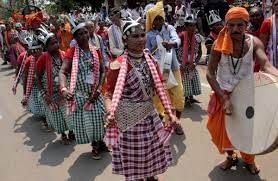
Why in News?
The vision of inclusive growth and community-led development is not an idea but an actionable strategy for Odisha in its 5T (transparency, technology, teamwork, time-limit, leading to transformation)-driven development model.
Tribal population in India
- India comprises 8.6% tribal population, has access to an enormous indigenous knowledge, which through recognition, adoption, and mainstreaming has the potential to provide sustainable solutions.
- According to article 342 of the Indian Constitution, the President may with respect to any State or Union territory specify the tribes, tribal communities, parts of, or groups within tribes or tribal communities as Scheduled Tribes in relation to that State or Union territory.
Odisha’s Special Development Councils (SDCs) initiative
- In a significant move towards preserving, promoting, and popularising tribal culture while also continuing with the development process, the Odisha government launched the Special Development Councils (SDCs) initiative in 2017.
- This is an active effort to preserve the culture and heritage of 62 tribes in the State under one umbrella while keeping economic development on course in the regions.
- The scheme, which covered 9 tribal-dominated districts and 60 lakh tribal households in 117 blocks, has now been expanded to 23 districts covering more than 84 lakh tribal people.
About Tribal Cultures:
- Communal living: Many tribal communities in India have a strong emphasis on communal living and sharing resources.
- They live in close-knit communities and often make decisions collectively.
- Self-Sufficiency: Tribe is a synonym for a self-reliant community, a tribe is a relatively closed society and its openness is inversely related to the extent of its self-sufficient pursuits.
- Connection with nature: Tribals have a strong connection with nature, with traditional beliefs and practices that revolve around the forests and animals.
- Folk arts and crafts: Tribals are known for their unique art forms, including pottery, weaving, and jewellery making.
- Spiritual beliefs: Tribals often have their own unique spiritual beliefs, which may involve the worship of ancestors, nature spirits, or deities.
Tribal Lifestyle and Sustainable development:
- Respect for the natural environment: Tribal traditional practices, such as using natural materials for housing, food, and medicine, and living in harmony with the cycles of nature.
- Community-based decision-making: Collective decision-making considers the needs of the community as a whole and ensures that decisions are made in a sustainable and equitable manner.
- Promotion of biodiversity: Tribals have developed practices to protect and promote diversity, which includes traditional methods of agriculture, such as intercropping and seed saving, as well as the protection of sacred sites that are important for the preservation of biodiversity.
- Conservation of natural resources: Sustainable practices involve limiting the use of resources to ensure their long-term availability, such as rotational farming or allowing forests to regenerate before harvesting timber.
- Emphasis on intergenerational knowledge sharing: Passing down knowledge to the next generation includes traditional knowledge of the natural environment and sustainable practices for managing resources.
- Protection of water resources: Tribal communities rely on water resources and have developed practices that can help to ensure that water is available for future generations, and can reduce greenhouse gas emissions.
- Regenerative agriculture: tribal communities have been practicing regenerative agriculture for centuries, which involves practices like crop rotation, intercropping, and regenerating soils with organic matter.
- These practices help to sequester carbon in the soil, which can help to mitigate climate change.
- Use of renewable energy: They have traditionally used renewable energy sources like wind, solar, and hydropower, which can be expanded and modernized to provide clean energy for more people.
Challenges faced by tribals in performing their lifestyle
- Discrimination: Tribal communities often face discrimination and prejudice from the dominant society, including limited access to education, healthcare, and other basic services.
- Land rights: Tribal communities have been displaced from their traditional lands due to industrialization, and mining, which has resulted in the loss of cultural identity, and social and economic marginalization.
- Climate change and environmental degradation: Climate Change, such as changes in rainfall patterns, increased frequency of natural disasters, loss of biodiversity, deforestation, pollution, and loss of habitat, has negatively affected their traditional livelihoods and ways of life.
- Socioeconomic marginalization: Many tribal communities have limited access to education, healthcare, and economic opportunities, which can result in poverty and social exclusion.
- Lack of political representation: Tribal communities often lack political representation and may not have a voice in decision-making processes that affect their lives.
- Cultural assimilation: Many tribal communities face pressure to assimilate into the dominant culture, which can lead to the loss of traditional knowledge, language, and cultural practices.
Government initiatives to conserve tribal culture:
- National Scheduled Tribes Finance and Development Corporation (NSTFDC), an apex Organization under the Ministry of Tribal Affairs in 2001 was brought into existence with the sole aim of economic upliftment of the Scheduled Tribes by way of extending concessional financial assistance to the target group under its various schemes.
- TRIFED’s Initiatives for Tribal Population: The Government plans to establish 50,000 Van Dhan Vikas Kendras, 3000 Haat Bazaars, etc.
- Central Sector Scheme: Institutional Support for Development & Marketing of Tribal Products / Produce.
- Pradhan Mantri Van Dhan Yojana: It is a market-linked tribal entrepreneurship development program for forming clusters of tribal Self Help Groups (SHGs) and strengthening them into Tribal Producer Companies.
- Scholarships for pre-matric, post-matric, and overseas education
- Support to National Scheduled Tribes Finance and Development Corporation
- Development of Particularly Vulnerable Tribal Groups (PVTGs): The scheme covers activities like housing, land distribution, land development, agricultural development, animal husbandry, construction of link roads, etc.
- Vocational Training in Tribal Area: The aim of the Scheme is to develop the skills of the ST youth for a variety of jobs as well as self-employment and to improve their socio-economic condition by enhancing their income.
- Centrally Sponsored Scheme: The mechanism for Marketing of Minor Forest Produce (MFP) through (MSP) and Development of a Value Chain for MFP’ as a measure of social safety for MFP gatherers.
Source: The Hindu
PM Street Vendor’s AtmaNirbhar Nidhi (PM SVANidhi) Scheme
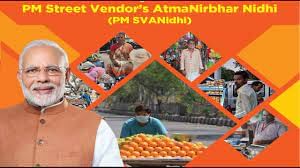
Why in News?
The Union Housing and Urban Affairs Ministry recently set a new target for its PM SVANidhi scheme for street vendors.
About PM Street Vendor’s AtmaNirbhar Nidhi (PM SVANidhi) Scheme
- It was launched by the Ministry of Housing and Urban Affairs on June 01, 2020.
- Purpose: To provide affordable Working Capital loans to street vendors to resume their livelihoods that have been adversely affected due to the Covid-19 lockdown.
- It is a micro-credit facility that provides street vendors with a collateral-free loan of Rs 10,000 with low rates of interest (below 12%) for a period of one year, aiding the vendors in getting back on their feet financially.
- The duration of the scheme initially was until March 2022. It has been extended till December 2024, with a focus on enhanced collateral-free affordable loan corpus, increased adoption of digital transactions and holistic socio-economic development of the Street Vendors and their families.
- Who is Eligible for the Loan?
- All vendors who have been vending from or before (March 24, 2020) and with a certificate of vending can avail the loan.
- As per the Street Vendors Act 2014, the Town Vending Committees (which comprises the local authorities and vendors from an area) issue a certificate of vending after a survey has been conducted of all the vendors.
PM SVANidhi Scheme Benefits
- Vendors can avail of a working capital loan of up to Rs. 10,000, which is repayable in monthly instalments in the tenure of one year.
- On timely/ early repayment of the loan, an interest subsidy @ 7% per annum will be credited to the bank accounts of beneficiaries through Direct Benefit Transfer on a quarterly basis.
- here will be no penalty on early repayment of loan.
- The scheme promotes digital transactions through cash back incentives up to an amount of Rs. 100 per month.
- The vendors can avail the facility of escalation of the credit limit on timely/ early repayment of loan.
- Implementation agency: Small Industries Development Bank of India (SIDBI)
Source: Indian Express
eSanjeevani

Why in News?
Union Health Minister recently informed the Rajya Sabha that the Centre’s telemedicine application eSanjeevani has completed 14,17,81,384 teleconsultations.
About eSanjeevani:
- It is a cloud-based integrated telemedicine solution of the Ministry of Health and Family Welfare, Govt. of India.
- It is a telemedicine app that provides both doctor-to-doctor and doctor-to-patient telecommunication.
- It is being designed, developed, deployed, and maintained by The Centre for Development and Advanced Computing (C-DAC), Mohali.
- Two modules of eSanjeevani:
- eSanjeevani AB-HWC:
- The doctor-to-doctor telemedicine platform, being implemented at all the Health and Wellness Centres (HWCs) in the country under the Ayushman Bharat (AB) Scheme of Government of India.
- It operates on a Hub-and-Spoke model wherein the ‘Ayushman Bharat-Health and Wellness Centers’ (HWCs) are set up at the state level, which is connected with the hub (comprising MBBS/ Specialty/Super-Specialty doctors) at the zonal level.
- It was rolled out in 2019.
- eSanjeevani OPD:
- It is the Patient-to-Doctor remote consultation services rolled out in 2020 amid the first lockdown imposed to fight the Covid-19 pandemic, while the Outpatient Departments (OPDs) in the country were closed.
- eSanjeevani AB-HWC:
- It enables people to get outpatient services in the confines of their homes.
Source: Indian Express
GS-III
National Digital Nagrik Forum
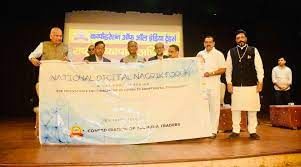
Why in News?
The Confederation of All India Traders (CAIT) has announced the creation of the National Digital Nagrik Forum.
About National Digital Nagrik Forum:-
- It is an online platform that aims to advance the rights of traders and consumers and shape policy to boost the digital trade economy.
- Objective: to raise awareness about digital regulations and help build the capacities of citizens to engage with innovation via expert sessions and instructional materials.
- It will conduct awareness camps, digital and physical dialogues, and training.
- It will reach out to stakeholders from the government, private sector, and civil society, including policymakers and other relevant stakeholders at the state level towards realizing its objectives.
Five Themes of National Digital Nagrik Forum:-
It will focus on five core themes.
- First: consumer protection and online safety with a core focus on efficient grievance redressal.
- Second: pitfalls of digital cartelization and how a level-playing field is necessary to discourage discriminatory and anti-competitive practices in the online world.
- Third: the potential of Indian digital technologies to not only transform retail and industrial trade but also boost employment and expand the investment footprint.
- Fourth: a first principles-based taxation policy that encourages certainty and productivity, especially for sectors with high growth potential, while preventing illegal activities such as tax evasion and money laundering.
- Fifth: the forum will study emerging technologies, such as blockchain and artificial intelligence, to assess their impact on retail trade and, at the same time, safeguard consumers’ interests.
About Confederation of All India Traders (CAIT):-
- Founded: 1990.
- HQ: New Delhi.
- It is the apex body of the trading community in India.
- Objective: representing and protecting the interests of traders.
- It has over 8 crore members and over 40,000 affiliated trade associations across India.
Functions of CAIT:-
- To render the best possible assistance to Trading Community.
- To communicate with Administrators concerned to seek redress of legitimate grievances of Traders.
- To impart education to Traders to upgrade their performance to render the most satisfactory service to consumers by adhering to fair trading policy.
- To lend full cooperation to the Govt. in streamlining the existing system.
- organize Seminars, Conferences and lectures, etc.
- To lay down a code of conduct for Traders to pursue business activity.
- To adopt digitalization, computerization, adoption & acceptance of digital payments and other significant digital technology in the existing business format of domestic trade of India.
- To create an Indian E-Commerce Portal promoting Indian Goods.
Source: Indian Express
Great Barrier Reef

Why in News?
Recently, UNESCO has removed Australia’s Great Barrier Reef from its “in danger” list.
Background:-
- Off late, Australia’s Great Barrier was under “serious threat” from pollution, warming of oceans, and constant coral bleaching events. Therefore, the UNESCO committee put the reef on the danger list.
- However, UNESCO removed the Reef from its “in danger” list, due to the Australian government’s efforts and commitments towards keeping the reef clean.
About Great Barrier Reef:-
- Location: Coral Sea (North-East Coast), off the coast of Queensland, Australia.
- It is the world’s most coral reef ecosystem composed of over 2,900 individual reefs and 900 islands.
- This reef structure is composed of and built by billions of tiny organisms, known as coral polyps, form the structure of coral reefs.
- Coral polyps: tiny, soft-bodied organisms and their base which is a hard, protective limestone skeleton called a calicle.
- These polyps have microscopic algae called zooxanthellae living within their tissues.
- The corals and algae have a mutualistic (symbiotic) relationship.
- Mutualism: a long-term relationship between individuals of different species where both individuals benefit.
- It is the largest aggregation of coral reefs in the world.
- It was selected as a World Heritage Site in 1981.
Advantages of Coral Reef:-
- Protect humanity from natural calamities.
- Provide revenue and employment through tourism and recreation.
- Provide habitats for fishes, starfish, and sea anemones.
Use of Coral Reef:-
- They are used in
- Coral blocks are used for buildings and road construction.
- The lime supplied by corals is used in cement industries.
Threats to Coral Reefs:-
- Anthropogenic activities: such as coastal development, destructive fishing methods, and pollution from domestic and industrial sewage.
- Due to increased sedimentation, over-exploitation, and recurring cyclones.
- Coral diseases: such as black band and white band due to infectious microorganisms introduced by the human population that lives in the coastal regions.
- Ocean Acidification.
- Overfishing and overharvesting of corals.
- Coral bleaching.
- Sunscreen chemicals.
- Many corals are threatened by the illegal harvesting of jewelry.
Coral Reef Areas in India:-
- Gulf of Mannar,
- Andaman and Nicobar Islands,
- Lakshadweep islands
- Gulf of Kutch.
Source: Times of India
|
63 videos|5408 docs|1146 tests
|





















